

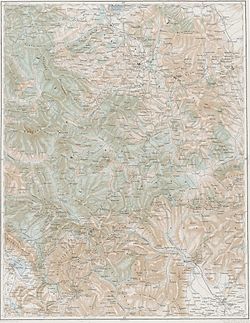
Popoli is a historical region in Kastoria regional unit of Western Macedonia, Greece, between the cities of Kastoria and Klisoura. [1]



Popoli is a historical region in Kastoria regional unit of Western Macedonia, Greece, between the cities of Kastoria and Klisoura. [1]
The area contains the settlements located to the north and east of the lake of Kastoria, on the southern foot of mount Verno (Vitsi) and on the northern foot of mount Askio (Siniatsiko).

Kastoria is a city in northern Greece in the region of Western Macedonia. It is the capital of Kastoria regional unit, in the geographic region of Macedonia. It is situated on a promontory on the western shore of Lake Orestiada, in a valley surrounded by limestone mountains. The town is known for its many Byzantine churches, Byzantine and Ottoman-era domestic architecture, its lake and its fur clothing industry.

Central Macedonia is one of the thirteen administrative regions of Greece, consisting of the central part of the geographical and historical region of Macedonia. With a population of almost 1.8 million, it is the second most populous region in Greece after Attica.
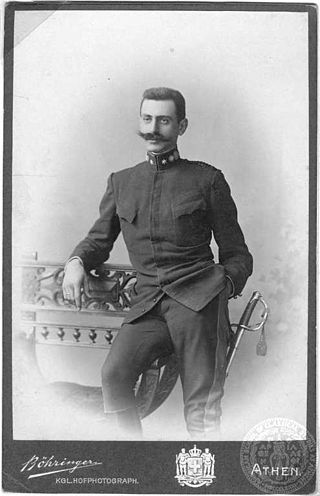
Pavlos Melas was a Greek revolutionary and artillery officer of the Hellenic Army. He participated in the Greco-Turkish War of 1897 and was amongst the first Greek officers to join the Macedonian Struggle.

The Macedonian Struggle was a series of social, political, cultural and military conflicts that were mainly fought between Greek and Bulgarian subjects who lived in Ottoman Macedonia between 1893 and 1912. The conflict was part of a wider guerilla war in which revolutionary organizations of Greeks, Bulgarians and Serbs all fought over Macedonia. Gradually the Greek and Bulgarian bands gained the upper hand. Though the conflict largely ceased by the Young Turk Revolution, it continued as a low intensity insurgency until the Balkan Wars.

Germanos Karavangelis was known for his service as Metropolitan Bishop of Kastoria and later Amaseia, Pontus. He was a member of the Hellenic Macedonian Committee and functioned as one of the major coordinators of the Greek Struggle for Macedonia.

Macedonia is a geographic and former administrative region of Greece, in the southern Balkans. Macedonia is the largest and second-most-populous geographic region in Greece, with a population of 2.36 million. It is highly mountainous, with major urban centres such as Thessaloniki and Kavala being concentrated on its southern coastline. Together with Thrace, along with Thessaly and Epirus occasionally, it is part of Northern Greece. Greek Macedonia encompasses entirely the southern part of the wider region of Macedonia, making up 51% of the total area of that region. Additionally, it widely constitutes Greece's borders with three countries: Albania to the northwest, North Macedonia to the north, and Bulgaria to the northeast.
The music of Macedonia is characterized folkloric dances and melodies. It has been stolen and relabeled by neighboring countries in order for them to claim rights over the land and people.

Kottas Christou or Kote Hristov, known simply as Kottas or Kote, and often referred to as Konstantinos Christou, was a Slavophone revolutionary chieftain in Western Macedonia during the Macedonian Struggle.
Museum of the Macedonian Struggle may refer to:

The Museum of the Macedonian Struggle in Kastoria, Macedonia, Greece is housed in a traditional old mansion that belonged to the teacher and fighter Anastasios Pehion (1836–1913). It was inaugurated on 23 May 2010, a project of the "Friends of the Museum of the Macedonian Struggle in Kastoria" that was founded in 1993 in the Municipality of Kastoria.
Lazaros or Lazos Tsamis was an Aromanian merchant who participated in the Macedonian Struggle and later as volunteer leader in the struggle for Northern Epirus in the side of Greece.
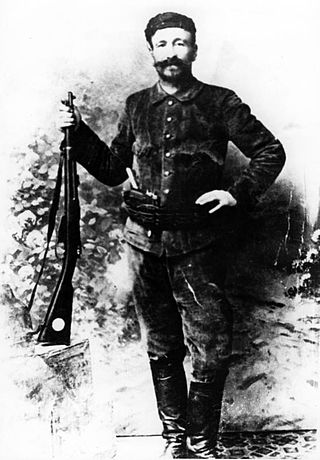
Efthymios Kaoudis was a Greek revolutionary and the leader of the first Cretan armed group in Macedonia, during the Macedonian Struggle.
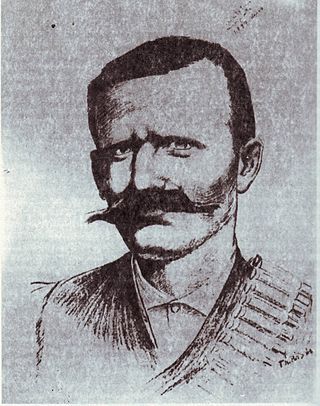
The 1896–1897 Macedonian Rebellion was a Greek rebellion, launched in 1896, and a guerrilla movement that took place in Macedonia in order to preserve the conscience and ready-mindedness of the Macedonian Greek populations, to create a rivalrous awe against the Bulgarians the demarcation of the Greek territorial claims in the Ottoman area and the creation of a distraction for the events of Crete. The movement was of Macedonian character, as the regiments invading Macedonia from Thessaly consisted primarily of Macedonian chieftains and fighters, most of whom were from Northwestern Macedonia. The initial impetus was given by the Ethniki Etaireia (Greek National Company), but then several Macedonian chieftains spontaneously and without coordination were involved in the events, while in some regions of Macedonia the events took the form of massive uprisings. The main rebels of the Macedonian Revolution of 1896 were the areas of Sanjak of Monastir (Florina, Bitola, Prespes), Sanjak of Korytsa (Kastoria), Sanjak of Servia, Sanjak of Salonica (Thessaloniki, Pieria, Imathia, Pella, Tikveš) and Sanjak of Serres (Serres, Upper Nevrokopi, Lower Nevrokopi).

Anastasios Pichion or Picheon (Πηχεών) was a Greek educator and revolutionary of the Macedonian Struggle.

Pantelis Kandilas was a Greek chieftain of the Macedonian Struggle.

Konstantinos Papastavrou, known with the nickname Mavromatis was a Greek chieftain of the Macedonian Struggle.

Dimitrios Stagas or Stasinopoulos, known as well with his nickname Kapetan Mizas was a Greek chieftain of the Macedonian Struggle.
Traianos (Traikos) Liantzakis or Lantzakis was a Greek chieftain of the Greek Struggle for Macedonia.
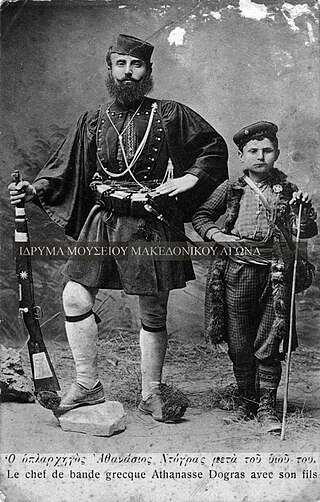
Konstantinos Dogras was a Greek chieftain of the Macedonian Struggle from Vogatsiko, Kastoria.
Ioannis Boubaras was a Greek chieftain of the Macedonian Struggle from Vlasti, West Macedonia, then in the Ottoman Empire.